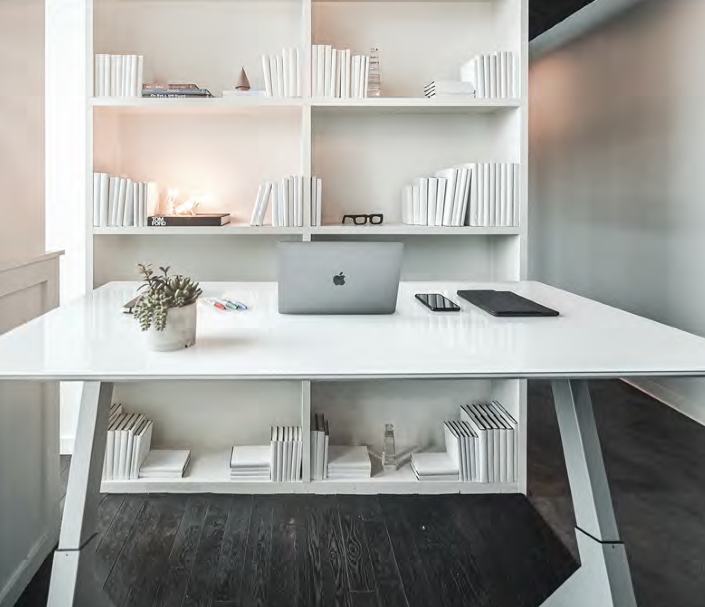
Standing Desks July 18, 2022
10 Tips For Optimizing Your Home Office
In 2013, over 380,000 days away from work accumulated due to ergonomic-related injuries. That means 1 out of 3 office workers lost time at work due to improper desk setup.
You may not have an office to request these ergonomic supplies from, but that makes it easier to do it yourself. Optimizing your home office is a great way to prevent injuries in the long run.
Keep reading for the best ways to optimize your home office.
1. Standing Desk
Humans weren’t meant to sit in chairs for prolonged times over many years. A standing desk is the best step you can towards home office optimization.
Standing desks offer many benefits. They lower your risk of heart disease, weight gain, obesity, and even help with back pain.
Standing desks can even help kids tasked with online school be more productive in their studies.
2. Footrest
What your feet rest on while you’re standing or sitting is also important. Since standing desks are adjustable, it’s still possible to sit during the day.
While sitting, you should work to maintain good posture, but investing in a footrest also helps with ergonomics. Allowing your feet to hang all day is not good for them, and leads to eventual pain.
The same goes for standing at your desk. Anti-fatigue mats help keep your feet comfortable during the day while helping to prevent injury.
3. Ergonomic Keyboard
Ergonomic keyboards are known to help prevent and/or ease any pain brought on by carpal tunnel syndrome. Your hands and wrists can rest in their natural state, allowing you to reduce the strain that comes with typing for prolonged periods.
There are different options for ergonomic keyboards available, so you’ll have to decide which works best for you and your needs.
4. The Right Chair
Besides organization, this is going to be the most subjective choice you make in your home office. What one person considers comfortable might make someone else’s back hurt within five minutes.
Luckily, there is no shortage of seating options available on the market to choose from.
5. A Good Mouse
An ergonomic computer mouse provides the same benefits as an ergonomic keyboard. It eases wrist strain and pain while helping you to stay productive.
There are also padded mouse pads available that can help with wrist pain while you work from home.
6. A Filing System
An optimized filing system can help you in the long run, especially if you’re self-employed.
Having folders for tax documents, contracts you may sign, even notes from important meetings, phone calls, or things you want to remember.
Creating a system also means getting to know yourself enough to know what it is you need from a home office. It can be an intimate process if you’d like it to be, but the main goal here is to keep your office organized.
7. Storage
This isn’t just for files. Organized storage space is important for your productivity in the long run. The easier you make it for yourself to find and put things away, the more likely you are to keep your storage organized.
Just like your filing system, create a customized storage system. This doesn’t mean buying special storage shelves and baskets (though you can if you’d like). It just means creating a home for everything in your office so you don’t have to spend too much time looking for products when they’re needed.
This means dedicated areas for specific products, and making sure nothing else is put there.
8. Optimal Location
Think about what distracts you while working, and do your best to not place your home office anywhere near it. Yes, this can still be achieved with limited space.
If you like natural light while you work, place your desk near a window. If you get distracted by looking out the window, maybe pick a spot far away from a window that still gives you good lighting.
Connectivity is another important thing to consider in your home office. Giving yourself the optimal connectivity in the house is best. Place your router near your work station if it’s possible.
9. Proper Lighting
Whether you achieve this through natural light or plenty of fixtures, bright lighting in your office is another way to achieve maximum productivity.
Placing your desk near a window or in a bright room is best if you have access. If not, creating a plan for your lighting erases any guessing about whether it’s going to work for you in the long run.
Test different bulb shades, or visit a store that has the bulbs and their shades on display. If you’re going for a cozy atmosphere, warmer bulbs are going to work for you. If you want a bright, white space, then whiter bulbs are what you want.
10. Inspiration
Take this tip however you’d like, but place inspiration in your home office.
Whether that’s art, plants, quotes, candles, books, journals, anything. If you look at it and want to work or feel inspired, then it should go into your space.
Get Creative With Your Home Office
No matter what tips you decide to take away from this article, remember that it’s your home office. You can do whatever you’d like with the space, as long as it inspires you to keep working and to be better.
Mix colors and textures. Bring in different scenes and feelings. Switch decorations up as often or as little as you’d like. Add a chair or couch in the corner if you feel like it, and remember to stand up throughout the day.
If you’d like to read more about home office design, or want to learn more about standing desks, check out our blog or contact us today.













